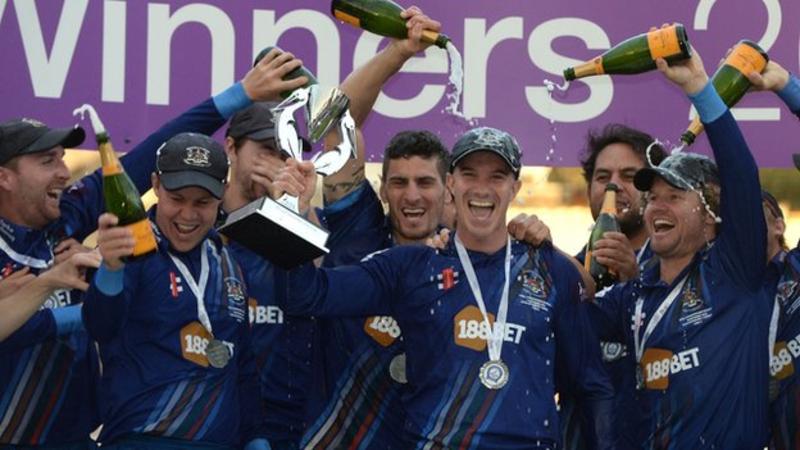For much of the game there was a slightly underwhelming feel about the Royal London One -Day Cup Final between Gloucestershire and Surrey at Lord’s on 19 September. The ground was far from full and Gloucestershire’s total of 220 looked well below par, particularly when Kumar Sangakkara and Rory Burns were easing Surrey to 143 for two in the thirty-fourth over . But they fell within three overs of one another, Gloucestershire fought back magnificently and the game turned into a genuinely dramatic contest with the West Country team winning by six runs. The result suited most disinterested observers, Surrey being, even without Kevin Pietersen, like Manchester United, the side people love to hate.
These games inevitably have an end of term feel to them partly because there are usually one or two players you know you will not be seeing again. This time there were ( probably) two.
I was surprised when I looked at the Surrey team list and saw the name Azhar Mahmood. Good heavens , I thought, is that the same Azhar Mahmood who was playing for Pakistan in the last millennium and for Surrey when they last won the County Championship , in 2002 ? Well, yes. Now aged forty, he was registered to play for Surrey in T20 matches in 2015 ( it’s a young man’s game) and was only playing in the final because of an injury to Zafar Ansari. ( He has not appeared in four-day cricket since 2012.)
Surrey knew Azhar could be a useful stand-in. It was in that role that he played for them in 2002, replacing regular overseas player Saqlain Mushtaq at the start of the season. In three matches Azhar took twenty wickets , including a match-winning eight for 61 against Lancashire at The Oval.
He did not let them down in the final. Azhar bowled his ten overs straight off and took two for 28.. At one point he had two for 15 off seven overs. It was a near faultless display of classic “English” bowling and a textbook demonstration of how to bowl at Lord’s , where the slope can cause problems for less experienced bowlers , as it occasionally did here for Surrey’s talented Curran brothers.
Azhar wasn’t able to save Surrey with the bat but it was as a batsman that he first made his name. In his first Test innings, against South Africa at Rawalpindi in 1997-98 he made 128 not out in the first innings, batting at number eight and putting on 151 for the tenth wicket with Mushtaq Ahmed, equalling the then world record . In the second innings he made 50 not out to help save the match. . Four months later , when Pakistan toured South Africa, he made centuries at Johannesburg and Durban. As a technically sound batsman with a fine array of shots, especially on the offside, and an energetic fast-medium bowler, he seemed to have a long Test career ahead of him. But he never quite lived up to that early promise and his last Test match was against England at Old Trafford in 2001.
He carried on in Pakistan’s one-day side for a few more years but a lot of his cricket has been played in England, for Kent ( between 2008 and 2012) as well as Surrey. He has a first-class double century to his name, against Middlesex at The Oval in 2005.and he has taken more List A wickets – 348 – than anyone currently playing English domestic cricket.
I said that there were ” probably” two players in the final whom we would not be seeing again because Azhar has not said he is retiring; who knows, he might carry on for ever. But Gloucestershire’s Geraint Jones had announced that this would be his last game as a professional cricketer.
Again, was it really as long ago as the Perth Test in 2006-07 – goodness , two Ashes whitewashes ago – that Jones had made his last appearance for England?
Jones, who played for Gloucestershire on loan from Kent in 2014, joined them as four-day captain for 2015 and had become a pivotal figure in the side. He was playing now as a batsman. (Oddly enough, there were three international wicket keepers playing at Lord’s , Jones, Sangakkara and Stephen Davies ; none of them kept wicket.) Jones played a brilliant innings of 50 off 65 balls with a six( off Azhar ) and four fours, by turns judicious and aggressive. Was it a match- winning innings? Well, if he hadn’t played it, Gloucestershire would surely have lost.
Jones, as he has himself acknowledged, will always be remembered for That Catch, taken on the final morning of the second Test against Australia at Edgbaston in 2005 to dismiss Michael Kasprovicz off the bowling of Steve Harmison. England won by two runs to level the series one-all. If the catch had not been taken, it is almost certain that Australia would have won not only the match but the series as well.
The next Test was a tantalizing draw at Old Trafford marked by an epic century from Ricky Ponting. So the teams went to the fourth Test at Trent Bridge still all square. In the first innings of the match a middling performance of 241 for five was turned into a commanding total of 477 by a sixth wicket stand of 171 between Jones and Andrew Flintoff. Jones made 85 and the irresistible Flintoff 102. England won another enthralling match and ultimately the series, their sixth in a row since Jones had joined the side.
All in all, even Jones’s severest critics, of whom there were many, could hardly deny that he played a significant part in one of the greatest Test series of all time. It must have been partly recognition of this fact that prompted the warm and generous reception he received from the Lord’s crowd as he walked out to bat in the final.
He came almost literally out of nowhere, the only Test cricketer to have been born in Papua New Guinea. He played a few games for Kent in 2001 and 2002, and at the end of that season the county decided to release the experienced Paul Nixon and give the gloves to Jones.
He did not let anyone down. In 2003 he scored close to a thousand runs and claimed 55 victims behind the stumps. By the end of that winter’s tour of the Caribeean, he was keeping wicket for England.
He was picked to replace Chris Read for the fourth and final Test at Antigua. As an opportunity to assess his wicket keeping skills, it was not ideal. In fact Jones could probably have sneaked off to the changing-room, put his feet up and read a few issues of Farmer’s Weekly (he had a life outside cricket ) and it wouldn’t have made much difference. West Indies made 751 for five (Brian Lara 400 not out, byes four).
Jones kept his place and often scored valuable and attractive runs, frequently in the company of Flintoff, and made a Test century against New Zealand in 2004.
But despite, or perhaps because of, his meteoric rise to the national side, almost as soon as he got there people started wondering whether it was all a terrible mistake and that he should never have been picked. The press were very harsh. He was never actually compared to Coleridge’s Ancient Mariner (“.. He stoppeth one in three…”) , but his glovework was ruthlessly dissected by the pundits and few doubted that Read was the better keeper. Jones, though, had the unstinting support of Duncan Fletcher and the England hierarchy. But after the triumph of 2005 his form with the bat fell away – although, ironically, his keeping seemed to improve – while, more significantly, England stopped winning Read came back during the series against Pakistan in 2006.
There was general astonishment when Jones was picked for the first Test against Australia in 2006-7 ahead of Read. But his time was almost up. Never having made a duck in his first 51 Test innings, he made two at Perth. In his last Test innings he was run out while waiting, outside his crease, for a leg before adjudication.
He was the only one of Michael Vaughan’s Ashes winners not to be named as one of Wisden’s Five Cricketers of the Year.
Bill Ricquier, 24/9/2015
Featured image: Gloucestershire’s win earned them their first trophy since 2004. Geraint Jones is holding the trophy. Image from BBC.




